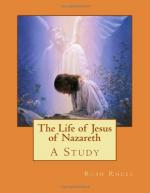64. The knowledge of the probable conditions of his childhood is as satisfying as the apocryphal stories are revolting. The lofty Jewish conception of home and its relations is worthy of Jesus. The circumstances of the home in Nazareth were humble (Matt. xiii. 55; Luke ii. 24; compare Lev. xii. 8). Probably the house was not unlike those seen to-day, of but one room, or at most two or three,—the tools of trade mingling with the meagre furnishings for home-life. We should not think it a home of penury; doubtless the circumstances of Joseph were like those of his neighbors. In one respect this home was rich. The wife and mother had an exalted place in the Jewish life, notwithstanding the trivial opinions of some supercilious rabbis; and what the gospel tells of the chivalry of Joseph renders it certain that love reigned in his home, making it fit for the growth of the holy child.
65. Religion held sway in all the phases of Jewish life. With some it was a religion of ceremony,—of prayers and fastings, tithes and boastful alms, fringes and phylacteries. But Joseph and Mary belonged to the simpler folk, who, while they reverenced the scribes as teachers, knew not enough of their subtlety to have substituted barren rites for sincere love for the God of their fathers and childlike trust in his mercy. Jesus knew not only home life at its fairest, but religion at its best. A father’s most sacred duty was the teaching of his child in the religion of his people (Deut. vi. 4-9), and then, as ever since, the son learned at his mother’s side to know and love her God, to pray to him, and to know the scriptures. No story more thrilling and full of interest, no prospect more rich and full of glowing hope, could be found to satisfy the child’s spirit of wonder than the story of Israel’s past and God’s promises for the future. Religious culture was not confined to the home, however. The temple at Jerusalem was the ideal centre of religious life for this Nazareth household (Luke ii. 41) as for all the people, yet practically worship and instruction were cultivated chiefly by the synagogue (Luke iv. 16); there God was present in his Holy Word. Week after week the boy Jesus heard the scripture in its original Hebrew form, followed by translation into Aramaic, and received instruction from it for daily conduct. The synagogue probably influenced the boy’s intellectual life even more directly. In the time of Jesus schools had been established in all the important towns, and were apparently under the control of the synagogue. To such a school he may have been sent from about six years of age to be taught the scriptures (compare II. Tim. iii. 15), together with the reading (Luke iv. 16-19), and perhaps the writing, of the Hebrew language. Of his school experience we know nothing beyond the fact that he grew in “wisdom and in stature and in favor with God and man” (Luke ii. 52),—a sufficient contradiction of the repulsive legends of the apocryphal gospels.




